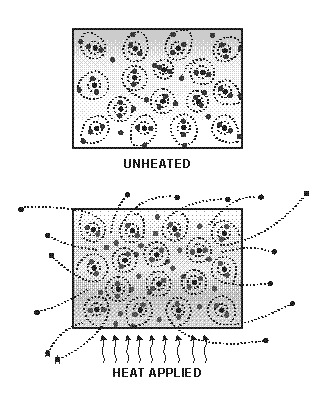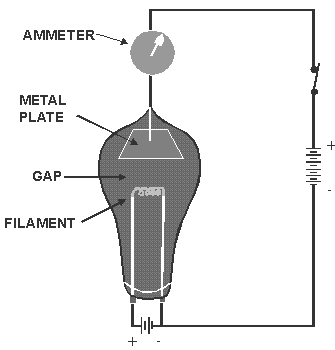Tubes
An Introduction to Electron Tubes
Current flows in the conductor of a completed circuit when a voltage is present. Current and voltage always obey certain laws. In electronics, the laws still apply. You will use them continuously in working with electronic circuits.
One basic difference in electronic circuits that will at first seem to violate the basic laws is that electrons flow across a gap, a break in the circuit in which there appears to be no conductor.
A large part of the field of electronics and the entire field of electron tubes are concerned with the flow and control of these electrons across the gap. The following paragraphs will explain this interesting phenomenon.
THERMIONIC EMISSION
Metallic conductors contain many free electrons, which at any given instant are not bound to atoms. These free electrons are in continuous motion. The higher the temperature of the conductor, the more agitated are the free electrons, and the faster they move.
A temperature can be reached where some of the free electrons become so agitated that they actually escape from the conductor.They "boil" from the conductor’s surface. The process is similar to steam leaving the surface of boiling water.
Heating a conductor to a temperature sufficiently high causing the conductor to give off electrons is called THERMIONIC EMISSION. The idea of electrons leaving the surface is shown in the illustration below of Thermionic emission.

Thermionic emission in electron tubes.
Thomas Edison discovered the principle of thermionic emission as he looked for ways to keep soot from clouding his incandescent light bulb.
Edison placed a metal plate inside his bulb along with the normal filament. He left a gap, a space, between the filament and the plate. He then placed a battery in series between the plate and the filament, with the positive side toward the plate and the negative side toward the filament. This circuit is shown in Edison's experimental circuit below.

Thomas Edison's experimental circuit of a light bulb.
When Edison connected the filament battery and allowed the filament to heat until it glowed, he discovered that the ammeter in the filament-plate circuit had deflected and remained deflected.
He reasoned that an electrical current must be flowing in the circuit—EVEN ACROSS THE GAP between the filament and plate. Edison could not explain exactly what was happening. At that time, he probably knew less about what makes up an electric circuit than you do now.
Because it did not eliminate the soot problem, he did little with this discovery. However, he did patent the incandescent light bulb and made it available to the scientific community.
Let's analyze the Edison's circuit. You probably already have a good idea of how the circuit works. The heated filament causes electrons to boil from its surface.
The battery in the filament-plate circuit places a POSITIVE charge on the plate (because the plate is connected to the positive side of the battery). The electrons (negative charge) that boil from the filament are attracted to the positively charged plate. They continue through the ammeter, the battery, and back to the filament.
You can see that electron flow across the space between filament and plate is actually an application of a basic law — UNLIKE CHARGES ATTRACT. Remember, Edison's bulb had a vacuum so the filament would glow without burning. Also, the space between the filament and plate was relatively small.
The electrons emitted from the filament did not have far to go to reach the plate. Thus, the positive charge on the plate was able to attract the negative electrons.
The key to this explanation is that the electrons were floating free of the hot filament. It would have taken hundreds of volts, probably, to move electrons across the space if they had to be forcibly pulled from a cold filament. Such an action would destroy the filament and the flow would cease.
The
application of thermionic emission that Edison made in causing
electrons to flow across the space between the filament and the plate
has become known as the EDISON EFFECT.
Diode tubes
Diode Operation
Measuring Diode Voltages
Diode Operation
Diode Construction
Plates
The Envelope
Plate Resistance
Diode Plates
Bias















